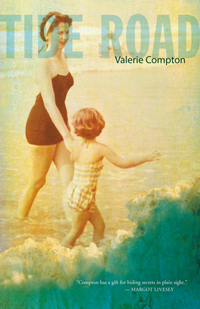Reviews
Fiction Review by Rita Donovan
Valerie Compton, Tide Road (Fredericton: Goose Lane, 2011). Paperbound, 232 pp., $19.95.
“The past is never dead. It is not even past.” I was reminded of William Faulkner’s meditation on the shaping power of the past while reading Valerie Compton’s Tide Road. This is a novel about concepts at their most archetypal: memory, light, sight, vision. A simple event—the disappearance of a young mother in Prince Edward Island in 1965—forms the foundation for this story of Sonia, her missing daughter Stella, and the family around them. We are given fragmentary information regarding the disappearance. Immediately, there are theories, one of which is “Stella ran away.” This idea is one Sonia supports, as she cannot face the possibility that her daughter may have drowned in the river, leaving Stella’s own daughter, Kate, motherless. Memory is used as a storytelling device and we become aware of its unreliability. We get only pieces of the picture when Sonia remembers, or reveals, them. We learn about relationships as they filter through Sonia’s consciousness, many as memory segments from 1939 to 1941, when Sonia is first an assistant to her father, a lighthouse keeper in Quebec, and later, as a “keeper of the light,” herself, in place of her husband, on Surplus Island, Malpeque Bay, P.E.I. It is “at the light” that Sonia learns who she is, and here that the language is most poetic. While at the
Quebec lighthouse, Sonia meets her future husband, Max, and later, at the P.E.I. lighthouse, she meets Pete, the young medical student who will influence her life.
We may wonder why we spend so much time with Sonia when, in 1965, there is a mystery to be solved, but it is this interface of past and present that gives the story power. We see the young Stella in the 1940s, a girl who has endured a permanent eye injury, and we know that later, in 1965, her lack of depth perception may be the cause of her death if, in fact, she has died. Nothing is written in stone, neither the “present” of 1965 nor the past. All is mutable. Vision is mutable. Sonia is a sometime-artist, fashioning seascapes and skyscapes in wool strands. Stella has trouble seeing clearly. Later, we learn that Pete has become an optometrist, helping others to see. Vision is not given the same to everyone. Sonia has to travel to her past to come to terms with the loss of Stella. In doing so, she relives her meeting with Pete and their encounters at the lighthouse. Pete provides the colour in Sonia’s life, and then he leaves: “In his absence all the hues of her life had been greyed out.” She does not realize, as the years pass, that she, like Stella, has had impaired vision.
When Sonia finds Stella’s diary and reads it, she is trying to understand her lost daughter. Stella had gone to Toronto as a young woman to try to “invent” herself, but returned to P.E.I. and married. When Stella gives birth to Kate, she suffers from postpartum depression. There are rumours of an abusive marriage. And there is the perpetual question of what has happened to Stella. While Sonia’s story is told in hints and recollections, Stella’s diary reveals a complicated and thoughtful person: “Seeing light, movement and colour, is seeing possibility—It’s seeing a flexible world that can become whatever you most need it to be.” And, perhaps the thematic thrust of the story: “I love it when the thing I want to see turns out to be the thing I really see.
But that’s so rare, that almost never happens.”
There is a symbolic “giving of light” that occurs in 1965, when Sonia visits an optometrist she is surprised to discover is Pete, returned to the island decades after their relationship. Pete has heard about Stella’s disappearance. All he can offer is his expertise: “How long have you had difficulty seeing what’s in front of you?” “Are things obscure?” He fixes her glasses, buys her a paintbox, and, though he can’t change the past or alleviate Sonia’s grief over Stella, in his own way he offers her a future.
In Tide Road, image builds on image, layered and buffered through time. Roads appear and disappear in the tide, land becomes island, people come together and fall away. Technically, this is ambitious. There are occasional glimpses of the freight words must carry. An attempt by Sonia to see things through the eyes of her other daughter, Rose, is awkwardly rendered. But, at its best, the novel’s scope and haunting vision reward the reader.
—Rita Donovan









